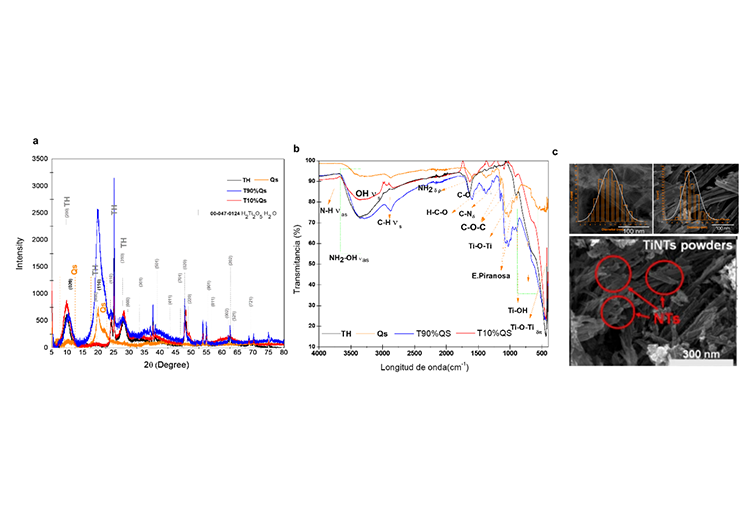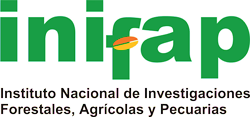Efecto bioestimulante de nanopartículas de titanatos de hidrógeno con quitosano en el frijol variedad frailescano
DOI:
https://doi.org/10.29312/remexca.v16i30.4049Palabras clave:
Phaseolus vulgaris L., agricultura moderna, clorofila, estimulación vegetal, nanomateriales, titanatos de hidrógenoResumen
El uso excesivo de fertilizantes y agroquímicos en la agricultura ha ocasionado un deterioro ambiental. En este contexto, la nanotecnología emerge como una alternativa sostenible para la agricultura moderna. El objetivo de este estudio fue evaluar el efecto bioestimulante de compuestos formados por nanopartículas de titanatos de hidrógeno y biopolímero de quitosano, en formulaciones con 10 y 90% de quitosano en el cultivo de frijol (Phaseolus vulgaris L.), variedad Frailescano, bajo condiciones de invernadero. La investigación se llevó a cabo en un invernadero de la Universidad Politécnica de Chiapas en 2024. Se empleó un diseño experimental en bloques completos al azar con cinco tratamientos: T1 (control), titanato de hidrógeno, quitosano, TH10QS (titanato de hidrógeno- 10% de quitosano) y TH90QS (titanato de hidrógeno- 90% de quitosano). El estudio reveló que los tratamientos con titanato de hidrógeno y TH10QS mejoraron significativamente el rendimiento del cultivo, aumentando el número de vainas, hojas y botones florales. En cuanto al contenido de clorofila (cα y cβ) y β-carotenoides, se observó un incremento por la aplicación de las nanopartículas. Este estudio demuestra que el uso de nanomateriales de titanatos y de quitosano tiene el potencial de impactar positivamente en el desarrollo del cultivo de frijol, mostrando efecto importante en variables clave de crecimiento y contenido de clorofila. Este enfoque permitió desarrollar estrategias innovadoras que mejoren la productividad agrícola y reduzcan el impacto ambiental.
Descargas
Citas
Arora, S.; Murmu, G.; Mukherjee, K.; Saha, S. and Maity, D. 2022. A comprehensive overview of nanotechnology in sustainable agriculture. Journal of Biotechnology. 355:21-41. https://doi.org/10.1016/j.jbiotec.2022.06.007.
Abdel-Maksoud, M. I. A.; Bekhit, M.; Sherif, D. M.; Sofy, A. R. and Sofy, M. R. 2022. Gamma radiation-induced synthesis of a novel chitosan/silver/Mn-Mg ferrite nanocomposite and its impact on cadmium accumulation and translocation in brassica plant growth. Países Bajos. International Journal of Biological Macromolecules. 194:306-316. https://doi.org/10.1016/j.ijbiomac.2021.11.197.
Ahmed, K. B. M.; Khan, M. M. A.; Siddiqui, H. and Jahan, A. 2020. Chitosan and its oligosaccharides, a promising option for sustainable crop production a review. Carbohydrate Polymers. 227:115331. https://doi.org/10.1016/j.carbpol.2019.115331.
Benavides-Mendoza, A.; González-Moscoso, M.; Ojeda-Barrios, D. L. and Fuentes-Lara, L. O. 2021. Biostimulation and toxicity: two levels of action of nanomaterials in plants. Nanotechnology in Plant Growth Promotion and Protection: recent Advances and Impacts. 283-303 pp. https://doi.org/10.1002/9781119745884.ch14.
Bernardes, M. F. F.; Pazin, M.; Pereira, L. C. and Dorta, D. J. 2015. Impact of pesticides on environmental and human health. Toxicology studies-cells, drugs and environment. 195-233 pp.
Castillo, P. C. H. D.; Castro-Velázquez, V. and Rodríguez-González, V. 2023. Adsorption and photocatalytic-conjugated activity of a chitosan-functionalized titanate coating for the removal of the drug clonazepam from drinking water. Alemania. Environmental Science and Pollution Research. 32:10553-10568. https://doi.org/10.1007/s11356-023-30215-2.
Castro-Velázquez, V.; Hernández-Castillo, P. C.; Díaz-Cervantes, E. and Rodríguez-González, V. 2025. Unraveling the role of chitosan in enhancing the photodegradation of ciprofloxacin by using chitosan-titanates composites: experimental and in-silico approach. Journal of Environmental Management. 375:124265. https://doi.org/10.1016/j.jenvman.2025.124265.
Ebrahimi, A.; Galavi, M.; Ramroudi, M. and Moaveni, P. 2016. Effect of TiO2 nanoparticles on antioxidant enzymes activity and biochemical biomarkers in pinto bean (Phaseolus vulgaris L.). Journal of Molecular Biology Research. 6(1):58-66. http://dx.doi.org/10.5539/jmbr.v6n1p58.
Farahi, M. S. M.; Yazdi, T. M. E.; Einafshar, E.; Akhondi, M.; Ebadi, M.; Azimipour, S.; Mahmoodzadeh, H. and Iranbakhsh, A. 2023. The effects of titanium dioxide (TiO2) nanoparticles on physiological, biochemical, and antioxidant properties of Vitex plant (Vitexagnus castus L.). Heliyon. 9(11):e22144. https://doi.org/10.1016/j.heliyon.2023.e22144.
Francis, D.V.; Abdalla, A. K.; Mahakham, A.; Sarmah, A. K. and Zhmed, A. F. R. 2024. Interaction of plants and metal nanoparticles: exploring their molecular mechanisms for sustainability. agriculture and crop improvement. Environment International. 190:108859. https://doi.org/10.1016/j.envint.2024.108859.
Gohari, G.; Mohammadi, A.; Akbari, A.; Panahirad, S.; Dadpour, M. R.; Fotopoulos, V. and Kimura, S. 2020. Titanium dioxide nanoparticles (TiO2 NPs) promote growth and ameliorate salinity stress effects on essential oil profile and biochemical attributes of Dracocephalum moldavica. Scientific Reports. 10:912. https://doi.org/10.1038/s41598-020-57794-1.
Hassan, E. O.; Shoala, T.; Attia, A. M. F.; Badr, O. A. M.; Mahmoud, S. Y. M.; Farrag, E. S. H. and El-Fiki, I. A. I. 2022. Chitosan and nano-chitosan for management of Harpophora maydis: approaches for investigating antifungal activity, pathogenicity, maize-resistant lines, and molecular diagnosis of plant infection. Journal of Fungi. 8(5):509. https://doi.org/10.3390/jof8050509.
INEGI, 2024. Compendio de Información Geográfica Municipal 2010. Sistema Nacional de Información Estadística y Geográfica. https://www.inegi.org.mx/app/mapa/espacioydatos/default.aspx?ag=07086.
Ithape, D.; Dalvi, S. and Srivastava, A. K. 2024. Chitosan-thiourea and their derivatives: applications and action mechanisms for imparting drought tolerance. Journal of Plant Physiology. 303:154365. https://doi.org/10.1016/j.jplph.2024.154365.
Jeyaraman, M. and Eltzov, E. 2025. Development of the alginate-gelatin-based biosensor for quick B. subtilis detection in foods. Talanta. 288:127739. https://doi.org/10.1016/j.talanta.2025.127739.
Jie, R.; Wu, H.; Yichao, E.; Ye, W.; Xiangpei, K. and Yin, K. 2024. Small particles, big effects: how nanoparticles can enhance plant growth in favorable and harsh conditions. Journal of Integrative Plant Biology. 66:1274-1294. https://doi.org/10.1111/jipb.13652.
Khairy, A. M.; Tohamy, M. R. A.; Zayed, M. A.; Mahmoud, S. F.; El-Tahan, A. M.; El-Saadony, M. T. and Mesiha, P. K. 2022. Eco-friendly application of nano-chitosan for controlling potato and tomato bacterial wilt. Saudi Journal of Biological Sciences. 29(4):2199-2209. https://doi.org/10.1016/j.sjbs.2021.11.041.
Khan, S.; Wang, A.; Liu, J.; Khan, I.; Sadiq, S.; Khan, A. and Bououdina, M. 2024. Bio-inspired green nanomaterials for tomato plant cultivation: An innovative approach of green nanotechnology in agriculture. Países Bajos. Chemical Engineering Journal Advances. 20:100677. https://doi.org/10.1016/j.ceja.2024.100677.
Kumari, K.; Rani, N. and Hooda, V. 2024. Unravelling the effects of nano SiO₂, nano TiO₂ and their nanocomposites on Zea mays L. growth and soil health. Reino Unido. Scientific Reports. 14(1):13996. https://doi.org/10.1038/s41598-024-61456-x.
Lian, J.; Zhao, L.; Wu, J.; Xiong, H.; Bao, Y.; Zeb, A.; Tang, J. and Liu, W. 2020. Foliar spray of TiO₂ nanoparticles prevails over root application in reducing Cd accumulation and mitigating Cd-induced phytotoxicity in maize (Zea mays L.). Chemosphere. 239:124794. https://doi.org/10.1016/j.chemosphere.2019.124794.
Li, P.; Xia, Y.; Song, K. and Liu, D. 2024. The impact of nanomaterials on photosynthesis and antioxidant mechanisms in gramineae plants: research progress and future prospects. Plants. 13(7):984. https://doi.org/10.3390/plants13070984.
Liu, G.; Yang, D.; Zhu, Y.; Ma, J.; Nie, M. and Jiang, Z. 2011. Titanate nanotubes-embedded chitosan nanocomposite membranes with high isopropanol dehydration performance. Reino Unido. Chemical Engineering Science. 66(18):4221-4228. https://doi.org/10.1016/j.ces.2011.06.005https://doi.org/10.1016/j.ces.2011.06.005.
Manimegalai, S.; Vickram, S.; Deena, S. R.; Rohini, K.; Thanigaivel, S.; Manikandan, S.; Subbaiya, R.; Karmegam, N.; Kim, W. and Govarthanan, M. 2023. Carbon-based nanomaterial intervention and efficient removal of various contaminants from effluents. A review. Chemosphere. 312(1):137319. https://doi.org/10.1016/j.chemosphere.2022.137319.
Morales-Santos, M. E.; Peña-Valdivia, C. B.; García-Esteva, A.; Aguilar-Benítez, G. y Kohashi-Shibata, J. 2017. Características físicas y de germinación en semillas y plántulas de frijol (Phaseolus vulgaris L.) silvestre, domesticado y su progenie. Agrociencia. 51(1):43-62.
Medina-Pérez, G.; Fernández-Luqueño, F.; Trejo-Téllez, L. I.; López-Valdez, F. and Pampillón-González, L. 2018. Growth and development of common bean (Phaseolus vulgaris L.) var. Pinto Saltillo exposed to iron, titanium, and zinc oxide nanoparticles in an agricultural soil. Appl. Ecol. Environ. Res. 16(2):1883-1897. https://doi.org/10.15666/aeer/1602-18831897.
Machanuru, R.; Shrivastava, M.; Singh, R.; Singh, B.; Chakraborty, D.; Ramalingappa, P. L. and Narayan, M. 2024. Plant enzymatic activity as an indicator of nano-TiO2 exposure in rice ecosystems, Plant Nano Biology. 10:100117. https://doi.org/10.1016/j.plana.2024.100117.
Ramírez-Rodríguez, S. C.; Preciado-Rangel, P.; Cabrera-Fuente, M.; González-Morales, S. and Ortega-Ortiz. H. 2024. Chitosan nanoparticles as biostimulant in lettuce (Lactuca sativa L.) plants, phyton-international journal of experimental botany. 93(4):777-787. https://doi.org/10.32604/phyton.2024.048096.
Sangerman-Jarquín, D. M.; Acosta-Gallego, J. A.; Schwenstesius-Rindermann, R.; Damián-Huato, M. Á. y Larqué-Saavedra, B. S. 2010. Consideraciones e importancia social en torno al cultivo del frijol en el centro de México. Revista Mexicana de Ciencias Agrícolas.1(3):363-380.
Senthamizh, R.; Vishwakarma, P.; Sinharoy, A.; Sinha, R.; Sharma, S. and Mal, J. 2025. Biogenic nanoparticles and their application in crop protection against abiotic stress: A new dimension in agri-nanotechnology. The Science of the Total Environment. 958:177884. https://doi.org/10.1016/j.scitotenv.2024.177884.
Tudi, M.; Daniel Ruan, H.; Wang, L.; Lyu, J.; Sadler, R.; Connell, D.; Chu, C. and Phung, D. T. 2021. Agriculture development, pesticide application and its impact on the environment. International journal of environmental research and public health. 18(3):1112. https://doi.org/10.3390/ijerph18031112.
Trela-Makowej, A.; Orzechowska, A. and Szymańskav, R. 2024. Less is more: The hormetic effect of titanium dioxide nanoparticles on plants. Science of the total environment. 910:168669. https://doi.org/10.1016/j.scitotenv.2023.168669.
Tripathi, D.; Singh, M. and Pandey-Rai, S. 2022. Crosstalk of nanoparticles and phytohormones regulate plant growth and metabolism under abiotic and biotic stress. Plant Stress. 6:100107. https://doi.org/10.1016/j.stress.2022.100107.
Vázquez-Herrera, P. y Taboada-Gaytán, O. R. 2023. El almacenamiento prolongado afecta la calidad nutricional y el tiempo de cocción del frijol ayocote. México. Revista Mexicana de Ciencias Agrícolas. 14(29):e3542. https://doi.org/10.29312/remexca.v14i29.3542.
Wang, X.; He, M.; Wang, X.; Liu, S.; Luo, L.; Zeng, Q.; Wu, Y.; Zeng, Y.; Yang, Z.; Sheng, G.; Ren, P.; Ouyang, H. and Jia, R. 2024. Emerging nanochitosan for sustainable agriculture. Suiza. International Journal of Molecular Sciences. 25(22):12261. https://doi.org/10.3390/ijms252212261.
Xinyi, L.; Muhammed, N. and Yukui, R. 2024. Effects of nanofertilizers on the mechanism of photosynthetic efficiency in plants: a review. Phyton-International Journal of Experimental Botany. 93(12):3197-3216. https://doi.org/10.32604/phyton.2024.059281.
Zayed, M. M.; Elkafafi, S. H.; Zedan, A. M. and Dawoud, S. F. M. 2017. Effect of nano chitosan on growth, physiological and biochemical parameters of Phaseolus vulgaris under salt stress. Egypt. Journal of Plant Production. 8(5):577-585. Doi. 10.21608/jpp.2017.40468.

Descargas
Publicado
Cómo citar
Número
Sección
Licencia
Derechos de autor 2025 Revista Mexicana de Ciencias Agrícolas

Esta obra está bajo una licencia internacional Creative Commons Atribución-NoComercial 4.0.
Los autores(as) que publiquen en Revista Mexicana de Ciencias Agrícolas aceptan las siguientes condiciones:
De acuerdo con la legislación de derechos de autor, Revista Mexicana de Ciencias Agrícolas reconoce y respeta el derecho moral de los autores(as), así como la titularidad del derecho patrimonial, el cual será cedido a la revista para su difusión en acceso abierto.
Los autores(as) deben de pagar una cuota por recepción de artículos antes de pasar por dictamen editorial. En caso de que la colaboración sea aceptada, el autor debe de parar la traducción de su texto al inglés.
Todos los textos publicados por Revista Mexicana de Ciencias Agrícolas -sin excepción- se distribuyen amparados bajo la licencia Creative Commons 4.0 atribución-no comercial (CC BY-NC 4.0 internacional), que permite a terceros utilizar lo publicado siempre que mencionen la autoría del trabajo y a la primera publicación en esta revista.
Los autores/as pueden realizar otros acuerdos contractuales independientes y adicionales para la distribución no exclusiva de la versión del artículo publicado en Revista Mexicana de Ciencias Agrícolas (por ejemplo incluirlo en un repositorio institucional o darlo a conocer en otros medios en papel o electrónicos) siempre que indique clara y explícitamente que el trabajo se publicó por primera vez en Revista Mexicana de Ciencias Agrícolas.
Para todo lo anterior, los autores(as) deben remitir el formato de carta-cesión de la propiedad de los derechos de la primera publicación debidamente requisitado y firmado por los autores(as). Este formato debe ser remitido en archivo PDF al correo: revista_atm@yahoo.com.mx; revistaagricola@inifap.gob.mx.
Esta obra está bajo una licencia de Creative Commons Reconocimiento-No Comercial 4.0 Internacional.


